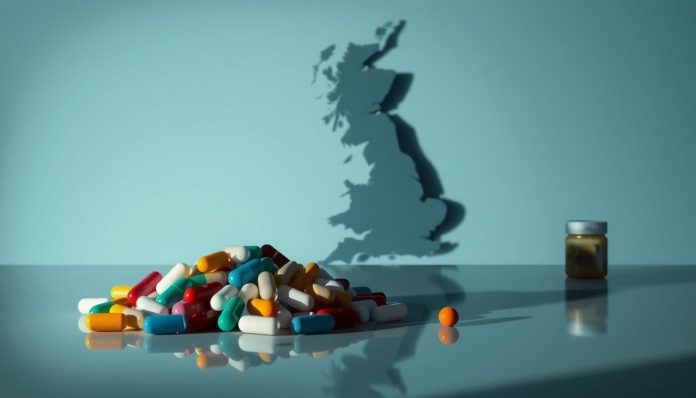Can a country famed for medical research also be viewed as the least friendly place to buy medicines in late 2025? This sharp question frames a striking contradiction. Britain leads in lab discoveries but now faces a public row over drug prices.
In 2025 a surge in VPAG rebates forced firms to return nearly 23% of revenues to the NHS. That shift has driven some list and private prices up, and prompted big firms to pause projects or pull plans in this key life sciences industry.
Executives warn the policy hit the investment market and left many people facing higher out‑of‑pocket costs or travel for medicines. Decisions by global names have already changed where research sits and how the nation competes in the wider world.
This article will unpack VPAG, show why 2025 flipped outcomes, and trace consequences for NHS access and household budgets this year. Readers will find clear evidence, stakes for the economy, and what policy choices lie ahead.
Key Takeaways
- VPAG rebates rose sharply in 2025, pushing complex price shifts across public and private channels.
- Major firms reversed or paused UK investments, cooling the life sciences climate.
- Higher private costs and delayed launches affect household finances and NHS patient access.
- The conflict pits fiscal control against timely access to innovation and jobs.
- Policymakers face a pivotal choice: recalibrate rebates to protect both affordability and investment.
Present snapshot: UK praised for research, criticised for prices — what’s driving the clash in late 2025?
By late 2025, praise for scientific output sat uneasily beside headlines on soaring medicine bills. Industry leaders, patient groups and finance pages all focused on a sudden, sharp pricing debate that mixed policy, market practice and public demand.
Eli Lilly’s Dave Ricks said the UK is “probably the worst country in Europe” for drug prices and warned that fewer new medicines would reach British patients if nothing changes.
ABPI warning lights: stalled VPAG talks and growing rift
The ABPI says talks with government broke down late August. Under the current rebate terms, firms returned nearly 23% of revenues on newer branded medicines, a central friction point that companies argue harms viability.
Mounjaro’s private price surge and cross‑border buying
Last month Eli Lilly raised private prices for Mounjaro by up to 170%, citing people travelling from Paris to buy UK stock. Comparative pricing across developed countries and constrained supply created incentives for arbitrage that pushed prices higher.
Why this landed on front pages and matters for personal finance
Coverage ballooned because weight‑loss and diabetes drugs touch many people and wallets. When private prices jump, households face higher out‑of‑pocket costs or longer waits for new medicines, and firms signal they may pause investment — as MSD, AstraZeneca, and Eli Lilly have already done.
For context on wider economic signals, consult economic indicators.
The UK’s Unique Pricing Mechanism: A Double-Edged Sword
The rebate maths flipped in 2025, turning strong uptake into a fiscal burden for manufacturers.
Understanding VPAG: the voluntary scheme for branded medicines
VPAG is a voluntary scheme where firms agree to cap branded medicines spend by repaying a share of revenue when growth exceeds set limits.
It trades price containment for predictable access — companies accept rebates so the NHS can plan budgets and secure supply.
Why 2025’s high rebates pushed prices up, not down
An unexpectedly large outturn raised the rebate to nearly 23% this year, cutting net receipts for many companies.
To protect margins, they increased list or private prices and tightened supply, which reduced choice and delayed some launches.
“Charging us for our own success,” industry leaders said, arguing steep clawbacks penalise strong uptake and harm growth.
- Companies rephased launches or limited volumes to manage rebate exposure.
- Government aims to contain NHS costs, but design choices can backfire on availability.
- Compared with other developed countries, this blended clawback-plus-broad-coverage model proved uniquely distortive in 2025.
Why Is the UK the Worst in Europe for Drug Prices? The consequences for investment and access
Recent policy shifts have prompted several major life‑science projects to stall or vanish from UK plans. That retreat has hit both jobs and clinical capacity.
Headline decisions include MSD cancelling a £1bn London research centre, AstraZeneca pausing a £200m Cambridge expansion, and Eli Lilly shelving a London gateway lab inside a planned £279m package.
Further information on this story is available via The Guardian.

Since 2022, thirteen major projects or companies changed plans, signalling a weaker environment for investment across the sector.
Deterred investment and cascading effects
Fewer facilities mean fewer local clinical trials and less domestic manufacturing. That slows access to new treatments and reduces spillover into wider UK research.
“Not an attractive environment,”
Global reallocation is visible: eli lilly is moving capital to a $6.5bn Houston manufacturing facility. Political pressures, including a deadline flagged by donald trump, tighten price leeway and sharpen board decisions.
| Company | Decision | Impact |
|---|---|---|
| MSD (Merck) | Cancelled £1bn London research centre | Loss of regional research jobs; fewer trials |
| AstraZeneca | Paused £200m Cambridge expansion; earlier Liverpool project scrapped | Slower manufacturing scale-up; regional setback |
| Eli Lilly | Shelved London gateway lab; investing in Houston | Capital relocated; reduced UK facility growth |
| Bristol Myers Squibb | Threatened not to launch new schizophrenia drug | Delayed patient access; fewer treatment choices |
In short, tighter rebate dynamics have trimmed net returns, prompting companies and firms to pause expansion. The result is slower access to cutting‑edge therapies and a weaker outlook for manufacturing and research in the United Kingdom.
What’s the alternative? Lessons from Europe and implications for growth, patients and the latest healthcare technology
Across Europe, some markets manage to protect public spending without freezing out innovation. They use clearer rules, staged access and value‑based deals that give companies a predictable market for new medicine.
Practical lessons include negotiated prices with transparent budget thresholds and conditional reimbursement while firms gather more evidence. These steps reduce sudden clawbacks and keep launches viable.
How other countries balance affordability, access and innovation
Outcomes‑based agreements and staged reviews let people get treatment earlier while data confirms the benefit. That limits up‑front risk to public money and keeps choice for patients.
“Stable rules and partnership models attract long‑term investment,” said a market access lead at Sanofi.
From manufacturing to medtech: keeping an attractive environment
- Recalibrating the current scheme to set realistic growth allowances and cap clawbacks would protect investment and reduce incentives to divert stock abroad.
- Fast‑track grants and data infrastructure can anchor manufacturing and medtech jobs.
- Outcomes‑linked contracts let pharmaceutical companies share risk without wrecking public budgets.
| Approach | Benefit | Impact on investment |
|---|---|---|
| Negotiated price + transparent threshold | Predictable budgets | Encourages long‑term projects |
| Conditional reimbursement | Faster patient access | Keeps launches in market |
| Outcomes‑based contracts | Shared risk | Improves commercial confidence |
| Targeted manufacturing incentives | Anchors high‑value jobs | Boosts sector growth |
Conclusion: Why Is the UK the Worst in Europe for Drug Prices?
Policy shifts this year pushed list and private charges higher and cooled investor confidence. The surge in VPAG clawbacks and stalled talks left people facing bigger private bills and longer waits for new medicines.
Executives, including Eli Lilly, have argued the country now looks like the worst country in Europe on drug costs, and Ricks said that without scheme changes, fewer new medicines and less investment will arrive.
Practical reform can steady prices and restore confidence by capping extreme clawbacks, add outcomes‑based elements, and offer multi‑year certainty. If government and pharmaceutical companies act, this year can mark a turning point for research, manufacturing, and household budgets.
For more Healthcare and Technology articles, please follow the link.


